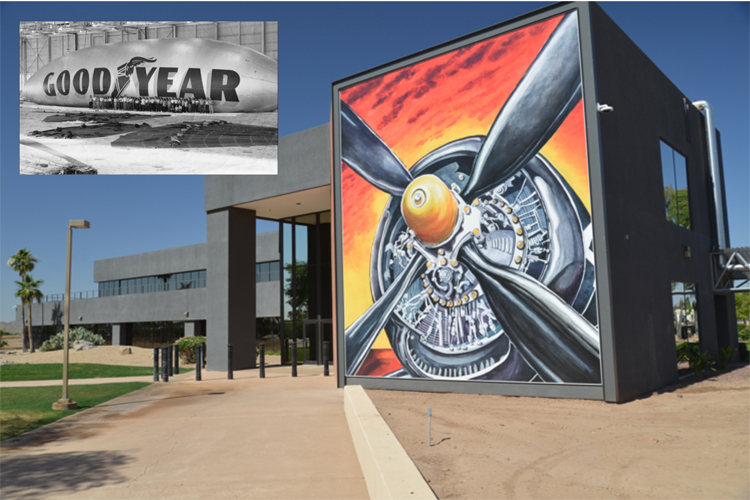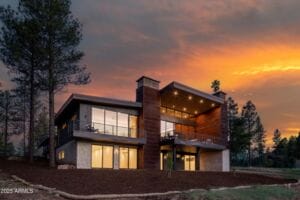When the FLITE Goodyear campus was built in 1942, it would go through many changes — including being the site where Goodyear blimps were built — before becoming the mixed-use site it is today.
The facility’s 19 buildings span 901,992 square feet, has 196,823 square feet of office space in 10 buildings, 705,169 square feet of industrial space in nine buildings, and seven parking spaces per 1,000 square feet. The campus has had many uses and tenants over its more than 75-year history.
According to the City of Goodyear website, FLITE Goodyear:
• Was established as the Litchfield Naval Air Facility that employed as many as 7,500 people at one time. During World War II, Goodyear Aircraft Corporation manufactured more than three million pounds of aircraft frames. After the war, the facility was utilized as a storage base for thousands of WWII aircraft that were salvaged.
• Goodyear Aircraft Corporation was where some of the famous blimps were manufactured that hovered over sporting events like the Rose Bowl football game and the Indianapolis 500. A group of women who worked at Goodyear Aircraft in Arizona manufactured the huge balloons of cartoon characters that hovered above floats at the Macy’s Department Store Parade in New York. They were known as “The Balloon Ladies.”
• In 1963, the Goodyear Aerospace Corporation replaced Goodyear Aircraft Corporation. It was later sold to Loral Defense Systems and eventually evolved by merger and acquisition into the current Lockheed Martin Corporation.
• The Litchfield Naval Air Facility was the training base for the Navy Blue Angels aerial demonstration team until 1968. That year, the Navy sold the airfield to the City of Phoenix, which named it the Phoenix-Litchfield Airport. In 1986, it was renamed the Phoenix-Goodyear Airport.
• In the 1980s, the 10,000 acres that remained of the original Goodyear Farms was sold to SunCor, which developed much of the land into the Palm Valley master-planned, mixed-use community located north of I-10 in Goodyear.
Today FLITE Goodyear’s tenants include Lockheed Martin, Gorbel and CavcoWest. Recent renovations have updated the space for functionality for the modern needs of the businesses.
[espro-slider id=232208]
DJ Burton, development manager with Reliance Management, is on site to oversee the renovations and improvements at FLITE Goodyear. Daryl Burton, property owner of FLITE Goodyear, has invested a lot of capital into the project to renovate and improve the site.
The leasing office at the front of the property is one of the facility’s original office structures in use today, DJ Burton said.
“We went through every nook and cranny of this place to get to know it and understand what we had and when we went through the attics and saw the structures on the blueprints, we saw that we had really great wood trusses,” Burton said. “Rather than just building your typical contemporary office building, we decided to take everything out, rework the ceiling so it could provide some value and build these office spots in here so you really get the old meets new feel. We featured scenes from the plant when it was first built during the war and right after the work was completed to show people what was done here.”
Since FLITE Goodyear was high-security facility as a former defense plant with Lockheed Martin, a few of the buildings were designed as a Sensitive Compartmented Information Facility (SCIF) space, which meant people needed a higher security clearance to enter.
“We could have torn all this down and built industrial spaces instead, but we wanted to preserve the history and our decision was reaffirmed when we uncovered more of that history,” Burton said. “All the wood is original, all the concrete floors, we’ve kept everything as close to the original as we can because people like that.”
Additional renovations included reorienting the buildings to be more tenant-friendly, which involved creating parking in the rear of the buildings to decrease the walking distance from the parking lot to the buildings, adding ornamental fronts to the buildings facing the street and creating an entrance in the back, Burton said.
“A lot of it was restoration,” Burton said. “A lot of it was taking buildings that were meant for outdated uses and making it usable for a modern tenant. We’ve been trying to go through and make it historically honest, but enjoyable for a modern tenant, so they need lots more light, and I’m going to use multi-light windows from the 1950s instead of traditional storefront windows.”
Burton said they are also planning on adding a pedestrian walkway between buildings, planting different gardens to diversify the landscape and adding more parking.
Harry Paxton, economic development project manager with the City of Goodyear, said the developers and the Burtons have captured the history of the facility through their building assessments and improvements.
“They’re doing different things that really honor and identify the history of the aviation and aerospace nature, such as the mural of a Corsair engine,” Paxton said.
The 27-by-33 mural decorating one of the street-facing buildings is colorful and stands out against the buildings’ darker colors. The Corsair is one of the planes that was worked on at FLITE Goodyear, and more murals will adorn other buildings. “We’re going to do lots of big murals of things that were created here because we want to remind people who are around here and who lease here the ingenuity of this place,” Burton said.
Another one of those murals will depict the Lockheed SR-71, Paxton said. “There were several patents that came out of that facility, one of the most notable was the synthetic aperture radar system that was developed there and that was used in the Lockheed SR-71 plane, which is known as a Blackbird.”
Some building improvements to prepare for the modern tenants involved removing the medians for future access, sandblasting stucco on some buildings to expose the original brick and working on the interior southern buildings by replacing short windows on the second floor with floor-to-ceiling glass windows, Paxton said. In some areas, they also removed raised floors and vaulted areas and added stairways to open up the space for future office use. One of the buildings even has a bank vault inside, a reminder of the facility’s diverse history.
“The blimp building where planes and blimps were manufactured back in the 1940s and 1950s was turned into a large office structure inside the hangar, and they tore that out and it’s becoming covered parking behind several of those buildings,” Paxton said.
Other renovations also include more visible signage in a vintage-like font along Yuma and Litchfield roads, Paxton said. One of those improvements is the word “Flite” on the water tower in the facility. “The water tower has always been a landmark in the City of Goodyear, and with it, they have the ability to promote the location,” Paxton said. The same water tower has a presence in the East Valley as well, standing proudly in downtown Gilbert.
In 2013, Paxton said the city expressed concern with what was going to happen with the facility. “Was it going to continue to age and not have a new life? But we couldn’t be happier with the owner that has continued to reinvest back in it and not only do that but captures as much as they can of the facility’s history.”
Interested in moving your business into Flite Goodyear or leasing opportunities? The office leasing is being shared between Emily Currie, Newmark Knight Frank; and Michael Crystal, Cushman & Wakefield; and the industrial leasing is being handled by Brian Gleason, Bonnie Halley and Melissa Marks of Colliers International. For more information, contact Newmark Knight Frank‘s Emily Currie.




